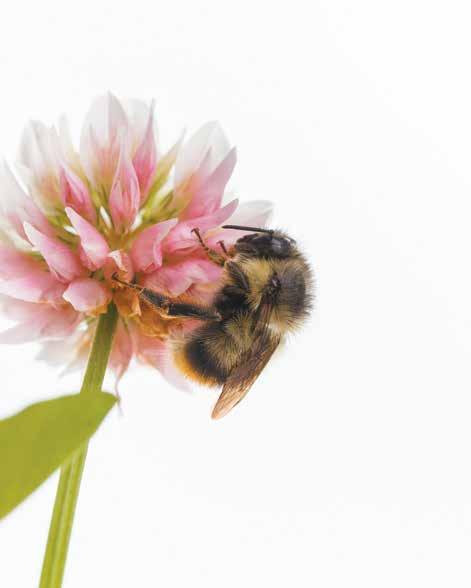
4 minute read
POLLINATOR-FRIENDLY YARDS
Gardening for Wildlife with Native Plants
by Betsy S. Franz
For some people, perfectly mowed lawns without a trace of a weed or an insect makes them proud, but they may not realize that this method of gardening and landscaping could be harming the local ecosystem and the important pollinators that we rely on to keep food and flowers reproducing. Pollinators are the creatures that move pollen grains from the male anther of one plant to the female stigma of another, thereby helping plants to produce seeds for the next generation. According to the U.S. Fish and Wildlife Service, these hard-working animals pollinate more than 75 percent of the world’s flowering plants and nearly 75 percent of our crops, including chocolate and coffee. Without pollinators, say biologists, neither the human race nor the Earth’s ecosystems would survive. Like many species, some pollinators are showing steady population declines, attributed in part to habitat loss and exposure to pesticides. The U.S. Environmental Protection Agency reports that grassy lawns occupy almost 2 percent of the total U.S. land mass, making grass the single largest irrigated crop in the country, which is why the way that people garden and maintain their landscapes can either harm or help pollinators. Many people spending more time at home last year due to the pandemic did more gardening and maintaining of their own landscapes, often without realizing the significance and impact of their activities. “Now, for the first time in its history, gardening has taken on a role that transcends the needs of the gardener. Like it or not, gardeners have become important players in the management of our nation’s wildlife,” writes Douglas Tallamy, an agriculture and natural resources professor at the University of Delaware, in his book Bringing Nature Home.
“Bees are what comes to mind when most people think of pollinators, but pollinators include many other species, including some flies, moths, butterflies, wasps and beetles, as well as bats, hummingbirds and even a few mammals,” says David Mizejewski, a naturalist with the National Wildlife Federation. Fortunately, the same principles that make home landscapes more inviting to pollinators also make it safer and friendlier for a wide variety of wildlife.
Rethink the Perfect Landscape
“One of the main dangers for pollinators is loss of appropriate habitat,” says Andre Kessler, an ecology and evolutionary biology professor at Cornell University. “To help them, give up your idea of the perfect, manicured landscape and aim to restore their preferred habitat.” Kessler suggests leaving part of a landscape a bit untidy by including native plants and mowing less often. “An island of native vegetation usually provides flowering plants year-round and, similarly important, nesting sites for native bees,” he says.
Tallamy advocates halving the total amount of space devoted to lawns in the continental U.S.—reducing water, pesticide and fertilizer use—and replacing grass with plants that sustain more animal life. Leave the leaves, sticks and debris, says Mizejewski. “Many species rely on leaf litter for food, shelter and nesting material. Many moth and butterfly caterpillars overwinter in fallen leaves before emerging in spring.”
Choose Appropriate Plantings
With so many different species of pollinators across the diverse terrain of America, few plants work for all locales. Most experts believe the best option is choosing native plants. The Pollinator Partnership (Pollinator.org) lists plants for each zone by ZIP code, as well as the pollinators they attract. There are also native plant societies in many areas that offer specific recommendations.
Eliminate the Chemicals
“Probably the most important thing the home gardener can do to overcome the pollinator and broader biodiversity crisis is to avoid using any pesticides,” says Kessler. “The uncontrolled use of insecticides and herbicides is the major reason for the dramatic loss of insect life in general and most other organisms depending on those insects.”
“It is now within the power of individual gardeners to do something that we all dream of doing: to make a difference,” Tallamy writes. “In this case, the difference will be to the future of biodiversity, to the native plants and animals of North America, and the ecosystems that sustain them.”
Betsy S. Franz is a freelance writer and photographer who seeks a loving, sustainable balance between the nature of our world and the inner nature of man.
Why Would You Let Your Family Live in an Unsafe Home?
You Should Start Caring About Dirty Electricity Right Now!
Dirty Electricity (EMC; Electro Magnetic Conducted) emissions creates poor power quality, and has led to early home appliance failures, industrial equipment control failures, GFI outlet failures, pulsating and flickering lights. Besides the likely cost of thousands in appliance damage there are also serious detrimental health effects such as:


n Deep sunburn type feeling n Skin Sores n Muscle Soreness n Hypersensitivity, burning pain or nerve numbness for an extended period n High Frequency electrical currents exposure can lead to long lasting post stimulus reduction of a nerve’s conductibility, which might relate to potential nerve injuries. i.e dropping foot, difficulty walking, finger cramping, neuropathy, eyelid twitching, tinnitus, and heart palpitations.




